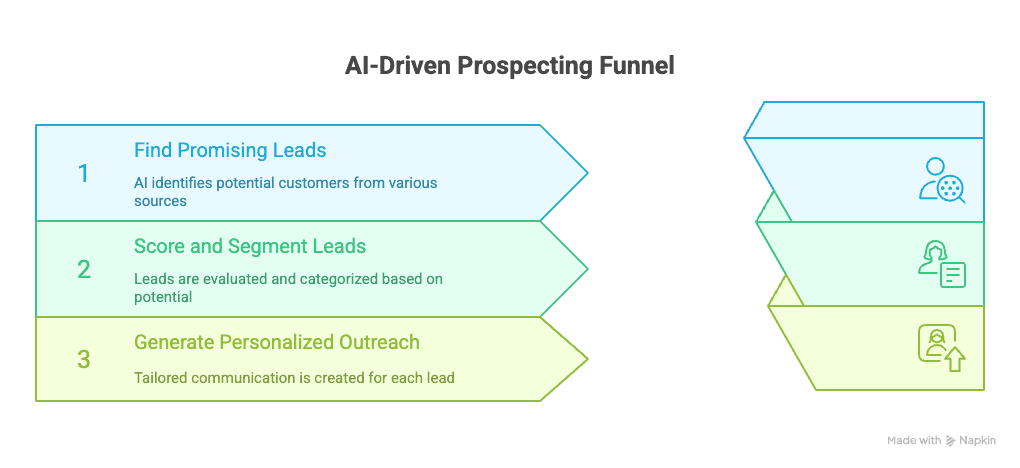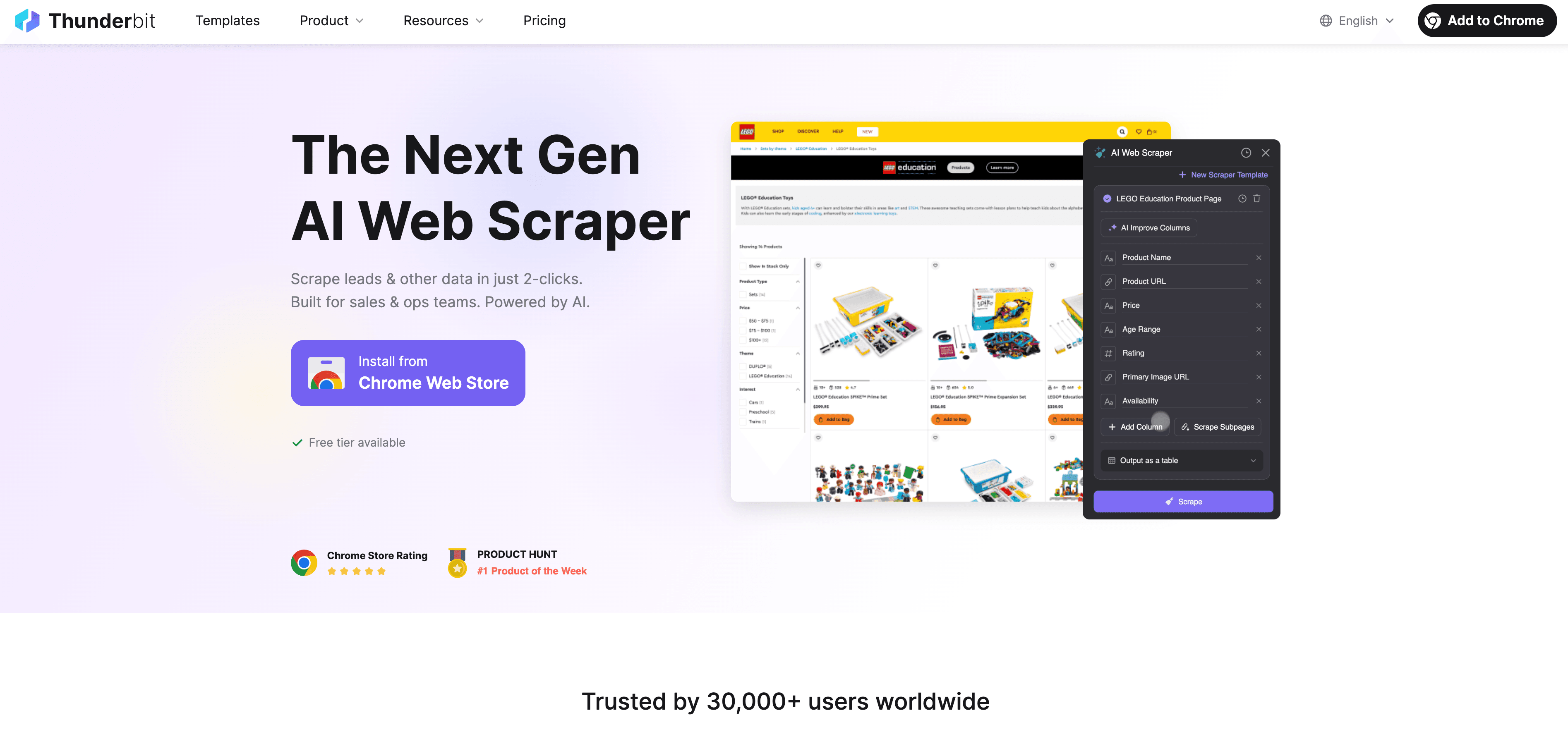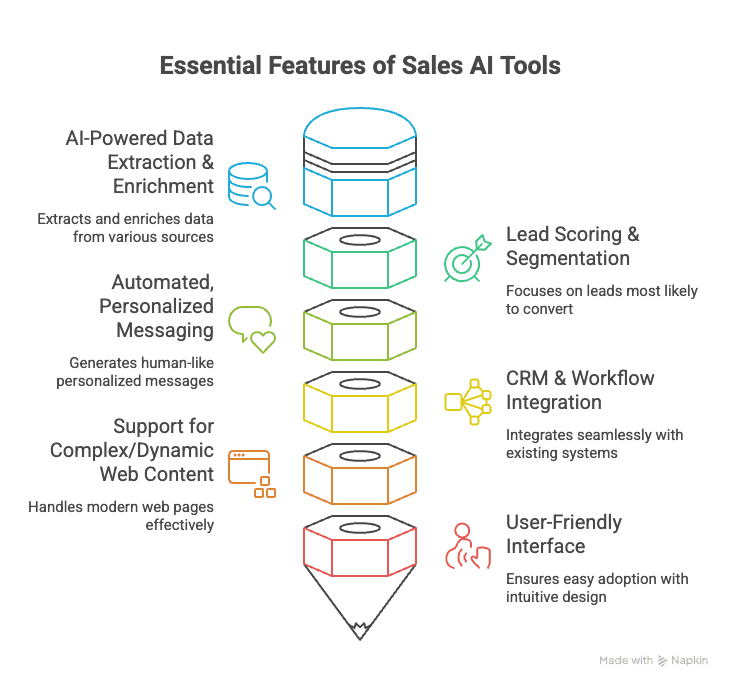Let’s be honest: sales prospecting used to feel like a never-ending scavenger hunt. I remember the days when teams would spend hours (sometimes days) scouring LinkedIn, copying and pasting contacts from obscure directories, and sending out the same cold email template to anyone with a pulse. It was a grind—like fishing with a stick and a string, hoping to catch something, anything, before the day ended.
Fast forward to today, and the landscape has changed dramatically. AI prospecting is taking the sales world by storm, and for good reason. According to recent research, . Sales reps now spend less time on mind-numbing research and more time building real connections. But what does AI prospecting actually mean, and how does it change the way we find and connect with leads? Let’s dig in.
What is AI Prospecting? A Fresh Take on Sales Outreach
AI prospecting isn’t just about automating cold emails or blasting out generic messages. It’s about embedding AI into the entire sales development process—from identifying the right prospects, to prioritizing them, to crafting personalized outreach that actually resonates.
In plain English, AI prospecting means using artificial intelligence to automate and enhance the process of discovering and engaging potential customers. Instead of manually building lists and sending the same email to everyone, AI-driven prospecting is context-aware and dynamic. It leverages machine learning, natural language processing, and predictive analytics to:
- Find promising leads from a wide range of sources (websites, directories, forums, social media, review sites—you name it)
- Score and segment those leads based on fit, intent, and likelihood to convert
- Generate personalized outreach that feels like it was written just for that person

The difference between AI prospecting and the old-school way is night and day. Traditional prospecting is like showing up to a party after everyone’s already left—the data is stale, and you’re left talking to empty chairs. AI prospecting, on the other hand, is like having a research assistant who reads everything on the internet in seconds and hands you a list of people who are actually interested, right now.
For example, imagine a sales rep who used to spend hours combing LinkedIn for leads in a specific industry, only to send them all the same email. With AI prospecting, the system can automatically pull a tailored list from multiple sources, score them for relevance, and even draft personalized intro emails that reference something unique about each prospect—like a recent product launch or a new job title. That’s not just automation; that’s intelligence.
Why AI Prospecting Matters for Sales Teams
Let’s be real: nobody gets into sales because they love data entry. The real value of AI prospecting is that it frees up sales reps to do what they do best—build relationships and close deals. Here’s why it matters:
- Time Savings: AI prospecting tools can reclaim up to reps used to spend on research and admin tasks. That’s more time for actual selling.
- Higher Lead Quality: AI analyzes multiple data points to surface leads that match your ideal customer profile and show real buying intent. According to Salesforce, compared to manual methods.
- Improved Personalization: AI-generated emails and messages have seen than standard, manually written ones.
- Real-Time Insights: No more chasing outdated contacts. AI tools keep your data fresh, lowering the cost per lead and preventing pipeline rot.
- Better ROI: , compared to just 66% of teams without AI.
Here’s a quick table to sum up the ROI-focused benefits:
| Use Case | AI-Driven Outcome (ROI) |
|---|---|
| Lead Generation & Research | 35% higher lead-to-meeting conversion, 47% more qualified leads in 90 days |
| Market Targeting & Outreach | Personalized targeting yields 15–25% response rates, 41% higher reply rates |
| Workflow Automation | 54% reduction in admin tasks, leads qualified 3.2× faster |
| Real-Time Data Enrichment | B2B contact data decays ~30%/year; AI keeps info fresh, lowering cost per lead |
()
The bottom line? AI prospecting helps sales teams find more and better leads, faster, while reducing the manual labor involved. No wonder .
How AI Transforms the Three Pillars of Sales Prospecting
Let’s break down the sales prospecting process into three key stages—and see how AI supercharges each one.
1. Prospect Discovery
This is where the hunt begins. Traditionally, it meant hours of Googling, scraping together lists from directories, or praying that your purchased list wasn’t already three years out of date. With AI, you can use web scrapers to uncover leads from diverse sources—web directories, forums, review sites, social networks, even dynamic pages that load as you scroll.
For example, with an , you can extract contact info from a niche industry association site or a conference attendee list in minutes. AI scrapers can handle tricky stuff like pagination, “Load more” buttons, and even dynamic comment sections.
2. Scoring & Segmentation
Once you’ve got a pool of leads, the next challenge is figuring out who’s worth your time. AI-driven lead scoring analyzes thousands of data points—role, industry, recent activity, even intent signals—to prioritize the leads most likely to convert. No more guessing or relying on blunt rules like “VPs get 5 points.”
AI can also segment your leads into clusters (by persona, industry, behavior) for tailored nurturing. According to McKinsey, than traditional methods.
3. Personalized Outreach
Here’s where the magic happens (okay, I said I wouldn’t use that word, but it really does feel like magic sometimes). Generative AI can draft emails or LinkedIn messages that reference specific details about each prospect—their role, recent company news, or even a comment they made on Twitter.
Instead of sending the same “Hey FirstName, I noticed you’re in Industry” email, AI can help you craft messages that actually feel personal. Tools like Lavender and Clay take this to the next level, generating tailored snippets for each lead at scale.
The result? —roughly double what generic cold outreach achieves.
Thunderbit: The Data Engine Powering AI Prospecting
Now, let’s talk about my favorite part of the stack—Thunderbit. (Yes, I’m biased, but for good reason.)

Thunderbit is an that helps you extract structured data from any website in just two clicks. Think of it as your always-on research assistant, ready to turn any web page into a lead list.
But here’s what really sets Thunderbit apart: instead of just grabbing raw HTML (which breaks every time a site changes), Thunderbit structures web content as Markdown before AI extraction. This means our AI can actually “read” the page like a human, understanding context, field labels, and data logic. It’s like giving your AI a pair of glasses and a notepad.
Why does this matter? Because it makes Thunderbit incredibly robust—especially on complex or dynamic web pages like Facebook Marketplace, review sections, or infinite scroll lists. We’ve all seen scrapers break when a site tweaks its layout. Thunderbit’s semantic approach means it keeps working, even when the web gets messy.
Thunderbit’s Key Features for Sales Prospecting
- AI-Suggested Fields: Click “AI Suggest Fields” and Thunderbit scans the page, recommending relevant columns to extract (e.g., Name, Title, Company, Email).
- Subpage Scraping: Need more details? Thunderbit can click into each result’s detail page and pull additional info, merging it back into your main list.
- Pagination & Scrolling: Handles “Next” buttons and infinite scroll automatically.
- Data Cleaning & Enrichment: Use AI field prompts to categorize, format, or even translate data on the fly.
- One-Click Export: Send your data straight to Excel, Google Sheets, Airtable, or Notion—no hoops to jump through.
- Templates for Common Sources: Instant templates for popular sites like LinkedIn, Shopify, or Yellow Pages.
Want to see Thunderbit in action?
Building Your AI Prospecting Tech Stack: More Than One Tool
Here’s the truth: no single tool does it all. The most effective AI prospecting setups rely on a flexible stack, where each component plays a specific role.
Here’s what a modern AI prospecting stack might look like:
| Function | Example Tools (Non-Competitors) | What They Do |
|---|---|---|
| Data Collection | Thunderbit | Scrape and structure lead data from any website |
| Data Enrichment | Clearbit, Snov.io | Fill in missing info (emails, firmographics, etc.) |
| CRM Integration | Salesforce, HubSpot | Store, manage, and track leads |
| Outreach & Sequencing | Salesloft, Outreach.io | Automate multi-step email and call sequences |
| AI Email Personalization | Lavender, Clay | Generate and refine personalized messages |
| Workflow Automation | Zapier, Make (Integromat) | Connect tools and automate data flow |
How it all fits together:
- Scrape leads from niche directories or websites with Thunderbit.
- Enrich those leads with missing data using Clearbit or Snov.io.
- Import the enriched leads into your CRM.
- Trigger personalized outreach using AI email tools like Lavender or Clay.
- Automate the workflow with Zapier or Make, so new leads flow seamlessly from discovery to engagement.
It’s like assembling your own sales robot—each part does what it’s best at, and together, you get a prospecting machine that never sleeps.
Key Features to Look for in Sales AI Tools
Not all sales AI tools are created equal. Here’s what I look for (and what I recommend to every sales ops leader):
- AI-Powered Data Extraction & Enrichment: Can the tool pull relevant data from anywhere and fill in the blanks? This is non-negotiable—your pipeline is only as good as your data.
- Lead Scoring & Segmentation: Does it help you focus on the leads most likely to convert? Look for predictive scoring and easy segmentation.
- Automated, Personalized Messaging: Can it generate emails or messages that feel human, not robotic? Personalization at scale is the holy grail.
- CRM & Workflow Integration: Does it play nicely with your existing systems? If you’re stuck exporting and importing CSVs all day, it’s not saving you time.
- Support for Complex/Dynamic Web Content: Can it handle modern web pages—dynamic lists, infinite scroll, or even PDFs? Thunderbit’s semantic parsing shines here.
- User-Friendly Interface: If your team needs a PhD to use it, adoption will tank. Look for drag-and-drop, natural language prompts, and good documentation.
Why do these matter? Because each one addresses a real pain point—whether it’s stale data, wasted time, or missed opportunities. The best tools make your team faster, smarter, and more effective.

AI Prospecting in Action: Real-World Use Cases
Let’s get practical. Here are a few real-world scenarios where AI prospecting delivers serious value:
1. Scraping Niche Directories for High-Intent Leads
Say you sell software to veterinary clinics. The big databases don’t have the small clinics you need. With Thunderbit, you can scrape a state’s veterinary association site, extract every clinic’s info, and even follow links to grab emails. One Thunderbit user did this with a conference attendee list—turning a public web page into a bespoke lead list overnight.
2. Segmenting Prospects by Buying Signals
You’ve got a big list, but who’s actually ready to buy? Use Thunderbit’s Field AI Prompts to analyze company descriptions or LinkedIn summaries for intent signals (like “hiring” or “expanding”). Then, score and segment leads based on fit and intent. The “hot” segment converts at nearly double the rate of generic leads.
3. Generating Context-Aware Cold Emails at Scale
Personalized emails work, but who has time to write 300 unique intros? With a combo of Thunderbit for data and Clay for email generation, you can merge unique snippets into each email—referencing a prospect’s recent blog post or product launch. The result? —way above the industry average.
4. Enriching CRM Data with Up-to-Date Contact Info
CRM data decays fast. Set up Thunderbit to scrape your key accounts’ websites every month, catching new executives or changes. Use Clearbit to check if LinkedIn URLs have changed. This keeps your pipeline fresh and reduces wasted effort chasing dead leads.
5. Real-Time Sales Triggers and Outreach
Timing is everything. Use AI to monitor for real-time intent signals—like funding news or product launches. When a trigger hits, the AI generates a summary and a suggested email draft. Reps can pounce with contextually relevant outreach, leading to higher response rates and shorter sales cycles.
AI prospecting isn’t a set-it-and-forget-it deal. Here’s how to get the most out of your tools:
- Combine Multiple Data Sources: Build richer lead profiles by merging data from your CRM, web scrapers, enrichment tools, and website analytics.
- Fine-Tune Personalization with AI Prompts: Don’t settle for generic output. Use custom prompts and rules to guide the AI—tailor your messaging for each scenario.
- Regularly Review and Update Scoring Criteria: Your ideal customer profile can change. Make sure your AI models and scoring rules keep up.
- Ensure Data Quality and Compliance: Deduplicate leads, verify emails, and always respect privacy laws and website terms. (Thunderbit has guidelines for responsible scraping.)
- Focus on Lead Quality, Not Just Volume: It’s tempting to chase big numbers, but the real win is higher conversion rates and pipeline value.
- Maintain the Human Touch: AI can tee up the conversation, but relationships are built person-to-person. Use the time AI saves you to add genuine, personal touches.
The Future of AI Prospecting: Trends and What’s Next
If you think AI prospecting is impressive now, just wait. Here’s where I see things heading:
- Real-Time Intent Signals: AI will soon be able to sense when a prospect is ready to buy—monitoring live data streams and alerting you at the perfect moment.
- Multi-Channel, Multi-Modal Outreach: Expect AI voice assistants making calls, personalized video messages at scale, and outreach across every channel your prospects use.
- Deeper Personalization: AI will integrate more context—personal preferences, communication style, even personality insights—to craft hyper-targeted messages.
- Autonomous AI Agents: Imagine AI SDRs handling the top-of-funnel process, from first contact to scheduling meetings, while humans focus on strategy and relationships.
- Platform Consolidation: The tech stack will get more integrated—expect unified platforms where you can orchestrate the entire prospecting flow with a single command.
- Ethics and Privacy: As AI gets smarter, so will the need for responsible data use and transparency. Trust will be a key differentiator.
The best advice? Experiment, iterate, and stay agile. The tools will keep evolving, and so should your workflows.
Conclusion: Unlocking the Full Potential of AI Prospecting
AI prospecting isn’t about blasting out more emails or building bigger lists. It’s about finding the right leads and engaging them with the right message, powered by a smart tech stack. The benefits are clear: higher conversion rates, more qualified pipeline, and less time wasted on grunt work.
Thunderbit stands out as the data engine that powers this new era—making it easy for anyone to collect, structure, and enrich lead data from anywhere on the web. But the real magic (okay, last time, I promise) happens when you combine Thunderbit with other best-in-class sales AI tools, from enrichment APIs to AI email generators.
If you’re still relying on manual research and generic outreach, now’s the time to level up. Assess your current workflow, identify the bottlenecks, and start experimenting with AI prospecting tools. Even a small pilot—like scraping a fresh lead list with Thunderbit—can open your eyes to what’s possible.
Remember, the future of sales isn’t about working harder. It’s about working smarter, with AI as your co-pilot. And hey, if you ever miss the old days of manual prospecting, you can always dust off that stick and string and go fishing on the weekend.
Ready to see what AI prospecting can do for your team? or . Your next best lead might be just a click away.
FAQs
1. What is AI prospecting and how does it differ from traditional sales prospecting?
AI prospecting uses artificial intelligence to automate and enhance the process of finding and engaging potential customers. Unlike traditional methods that rely on manual research and generic outreach, AI prospecting leverages machine learning and predictive analytics to identify promising leads, score and segment them, and generate personalized outreach. This results in more relevant, timely, and effective sales efforts.
2. What are the main benefits of using AI prospecting tools for sales teams?
AI prospecting tools save significant time by automating research and administrative tasks, improve lead quality through advanced data analysis, enable highly personalized outreach, provide real-time insights with up-to-date data, and deliver better ROI. Sales teams using AI are more likely to meet their quotas and report higher revenue growth compared to those relying solely on manual methods.
3. How does Thunderbit enhance the AI prospecting process?
Thunderbit is an AI-powered web scraper Chrome Extension that allows users to extract structured data from any website quickly and efficiently. It structures web content as Markdown before AI extraction, making it robust even on complex or dynamic web pages. Thunderbit offers features like AI-suggested fields, subpage scraping, automatic pagination handling, data cleaning, and seamless export to various platforms, making it a powerful tool for building high-quality lead lists.
4. What should I look for when choosing sales AI tools for my tech stack?
Key features to consider include AI-powered data extraction and enrichment, lead scoring and segmentation, automated personalized messaging, CRM and workflow integration, support for complex web content, and a user-friendly interface. These features ensure your team can efficiently gather, qualify, and engage leads while minimizing manual effort and maximizing results.
5. Can you give examples of real-world use cases for AI prospecting?
Yes! Real-world use cases include scraping niche directories for high-intent leads, segmenting prospects by buying signals, generating context-aware cold emails at scale, enriching CRM data with up-to-date contact information, and triggering real-time outreach based on sales signals like funding news or product launches. These applications help sales teams target the right prospects with the right message at the right time.
Learn more: